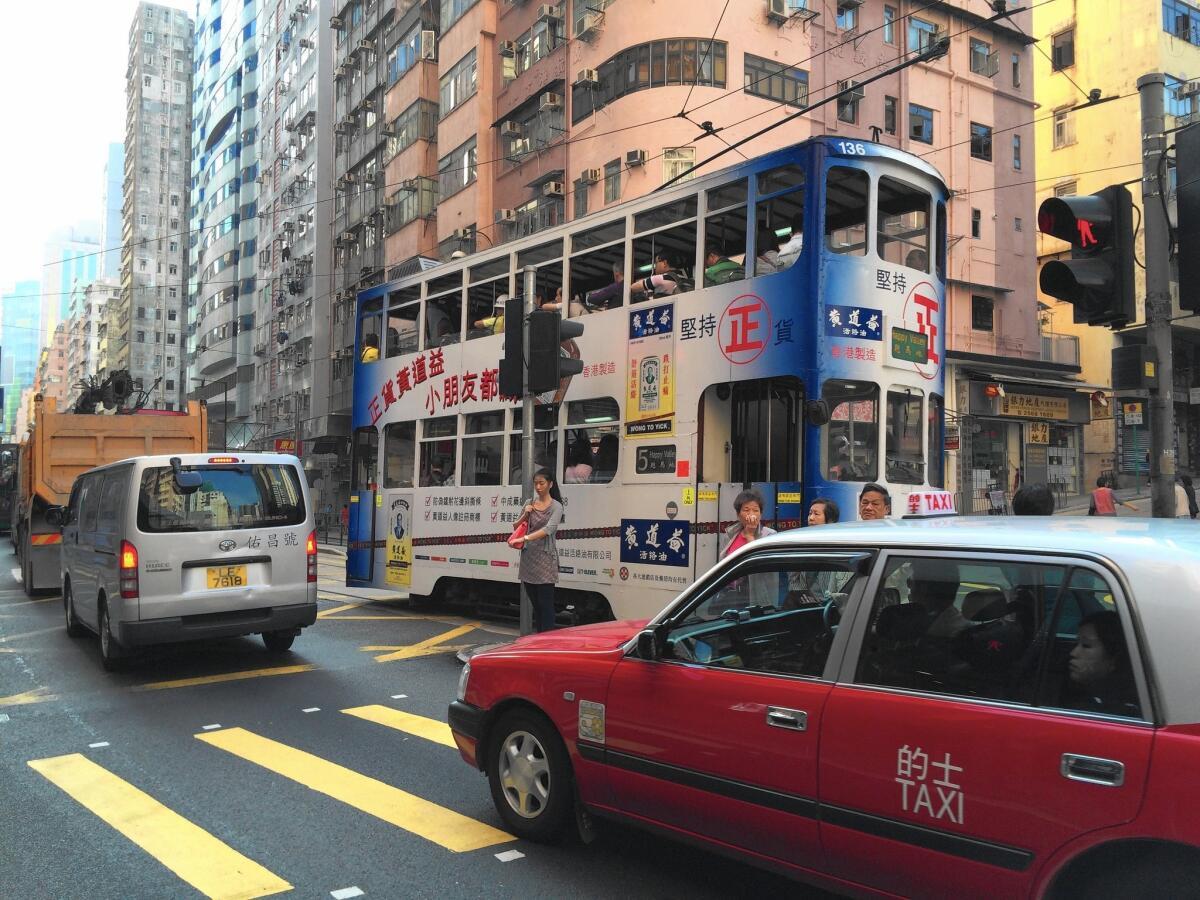In Hong Kong, trams offer a ride like no others

- Share via
HONG KONG — At Rumsey Street and Des Voeux Road, two middle-aged women step into the hot-pink double-decker tram, gripping large black plastic bags filled with pungent dried cod and shrimp.
Several men in bespoke suits, one carrying a sleek Armani briefcase, board alongside them, chatting in a seamless mix of Cantonese and English.
As they climb the narrow spiral staircase to the upper level, the traffic light turns green. The conductor rings a bell — ding, ding — and the oversized vehicle, adorned with advertisements for the local Wing Wah cake shop, glides east from historic Sheung Wan toward the trendy Wan Chai area, and eventually the Causeway Bay shopping district.
The smell of sweet potatoes and chestnuts roasting in food carts wafts through the tram’s open-air windows in the muggy afternoon.
The tram slowly maneuvers through a man-made canyon rimmed by lofty buildings. Near Queen’s Road and Jubilee Street, it passes the Center, a 73-floor skyscraper that is among the tallest in this financial hub of 7.2 million people.
“This is Hong Kong,” says Mimi Chu, 22, gesturing toward other riders and the view from the tram. “And this is the transportation for Hong Kongers, and the best for tourists and people who want to explore.”
Passengers taking in the city’s attractions see Peking duck being served at quaint restaurants positioned along the route. In North Point, the trams pass through the Chun Yeung Street wet market, where food shoppers try to pick the freshest fish or frogs.
For 110 years, trams have ferried passengers across the island, a former British colony that returned to Chinese rule in 1997. Many visitors count on going for a ride as part of their Hong Kong experience, which in some cases include special parties or gourmet meals aboard the tram.
Their rides may be in trams of almost any color, often covered with advertisements for businesses ranging from major international companies to local enterprises such as Ling Chi Medicine, which manufactures shiling oil.
Locals call it the “ding ding” because of the virtually constant bells ringing around the city to warn pedestrians to stay clear when the cars are moving.
“We are part of what makes Hong Kong not only a great city, but also a place with a soul,” says Emmanuel Vivant, managing director of Hong Kong Tramways, which operates independently from other public transportation.
The service, which began in 1904 with about two dozen trams imported from Britain, “is still going strong” in meeting people’s needs, he says.
Vivant says the trams offer a far different experience from faster, more expensive subways and buses that are mainly about getting people from Point A to Point B without much flavor. In addition, the trams, which run on electricity and have seen about $20 million in upgrades in recent years, “are the greenest, the most affordable and the most convenient transport,” he says.
They travel at a leisurely pace, about 6 mph. Trams run east and west on six separate lines.
With a base fare of $2.30 (about 30 cents), rides are cheap, which means the trams attract throngs of passengers, roughly 200,000 daily. The 160-plus vehicles in operation serve more than 100 stations, filling the city’s streets from about 5:30 a.m. until midnight each day.
“They’re so large and full of life,” Shirley Wcoy says while sitting on the upper-level of the tram near Wan Chai. “Tourists, locals like me, all come together and ride.... Some for pleasure. Others for business.”
Wcoy, making her way to her apartment near Causeway Bay from her job as a preschool teacher, says the trams have helped her get wherever she needed to go since she moved to Hong Kong from the Philippines in 2008.
As the tram moves along, some tourists bend and strain to read the street signs. There’s no shouting out of the names of stops by the conductor or automated recording to indicate when it’s time to get off.
Residents such as Phyllis Wan, who disembarks in Wan Chai, just seem to know when their stop is near. She says the tram’s chime is almost soothing.
“You only really notice it — the sound — if you’re a tourist or have been gone for a long time,” says Wan, who travels for extended periods to visit family in Guangzhou, a city in mainland China. “The sound always lets me know I’m home.”
Wan says that for many weeks beginning in late September her commute was altered by pro-democracy protests that disrupted tram service as well as other aspects of life in the city. She abandoned one line and walked several blocks around the protest sites to catch a different line for her commute to work.
The tram operation, owned by French companies RATP and Transdev, had to adjust because of the protests, says Vivant, noting that teams of mechanics traveled from the company’s depot on the western side of the island almost daily to work on vehicles.
For Chu, a community college student and full-time waitress operating on a tight budget, riding the tram means getting from her home in Sheung Wan to her job in Causeway Bay in an efficient, pleasurable fashion.
“Being a student adds up,” she says, looking out the window at a group of young revelers laughing loudly on a Causeway Bay street corner. “I’m very glad to have something inexpensive and reliable when so much around me is excessive and just so expensive.”
kurtis.lee@latimes.com
Twitter: @kurtisalee
More to Read
Sign up for Essential California
The most important California stories and recommendations in your inbox every morning.
You may occasionally receive promotional content from the Los Angeles Times.













